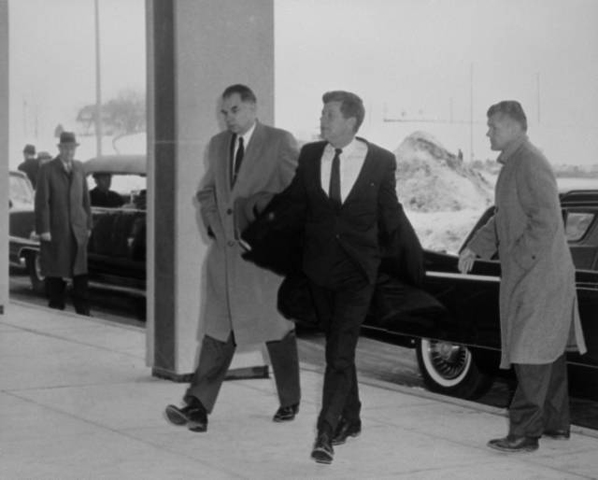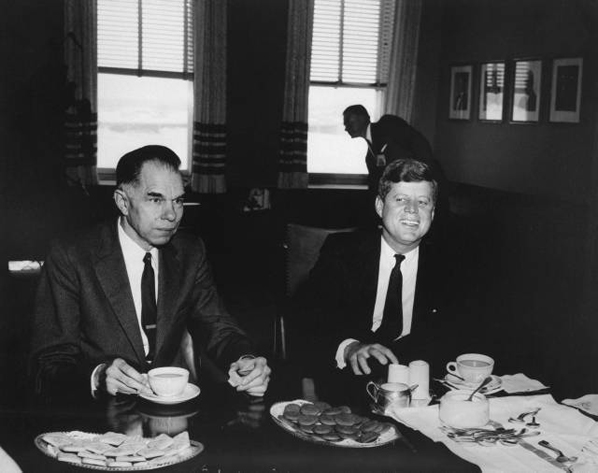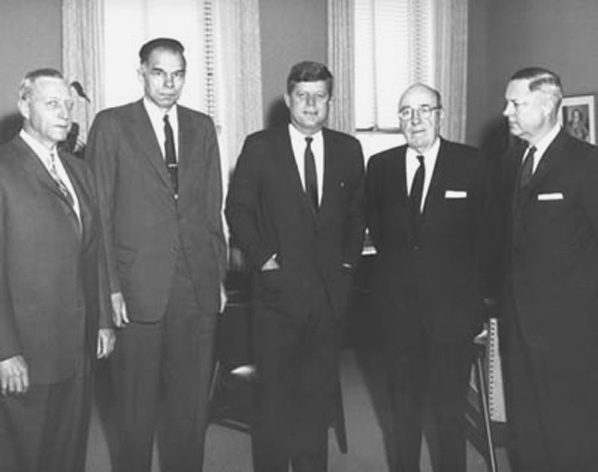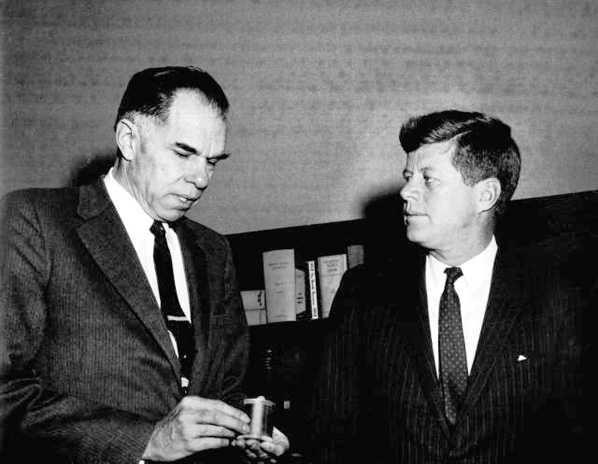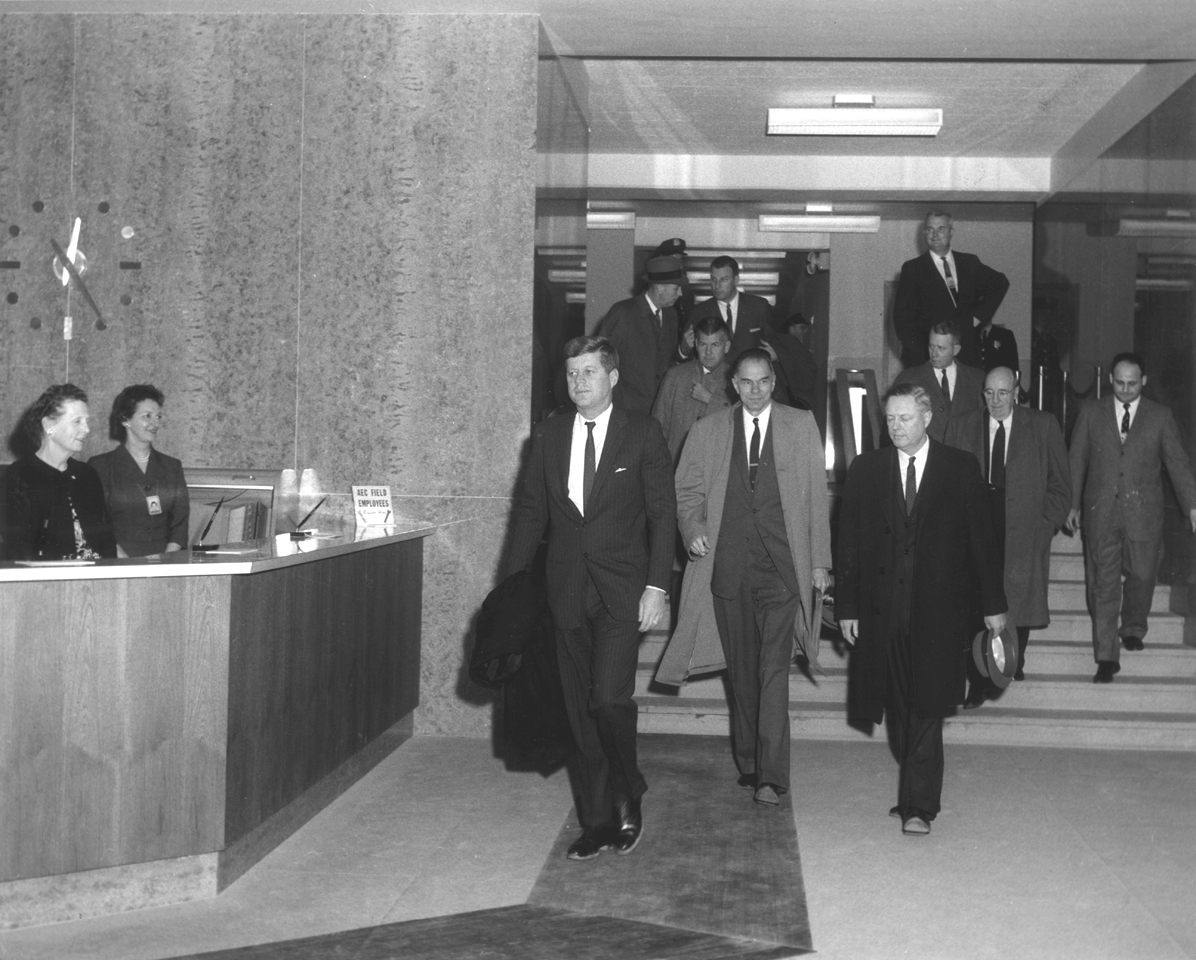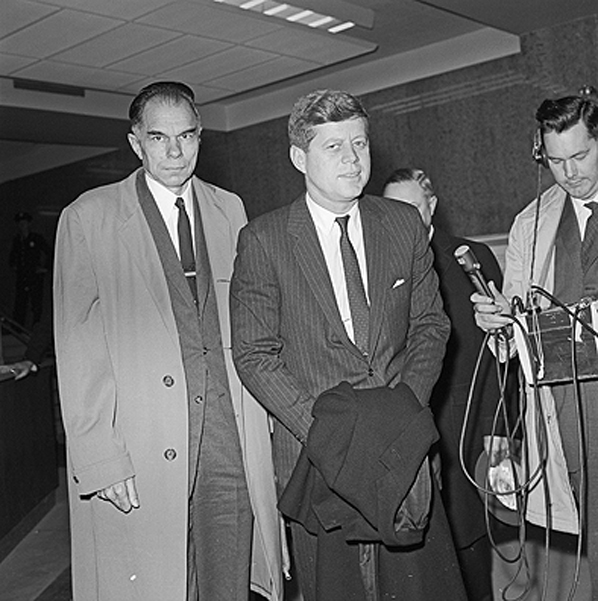President Kennedy's AEC Briefings
President John F. Kennedy
U.S. Atomic Energy Commission (AEC) Briefings
February 16, 1961; Germantown, Maryland

President Kennedy, General Luedecke, Chairman-Designate Seaborg, Acting Chairman Graham, Commissioner Olson, and Commissioner Wilson
Twenty-seven days after his inauguration as the thirty-fifth President of the United States, forty-three-year-old President John F. Kennedy took an unannounced seventeen-minute helicopter flight from the White House to the Atomic Energy Commission (AEC) headquarters in Germantown MD for three hours of briefings led by Dr. Glenn T. Seaborg, the President's nominee for Chairman of the AEC. Dr. Seaborg would become the longest serving AEC chairman, serving ten years from March 1, 1961, to August 16, 1971.
Images from President Kennedy's Visit
Click on thumbnails to enlarge photographs with captions
President's appointment schedule AEC Organization Chart, Nov. 18, 1960 President's handwritten notes
Dr. Glenn T. Seaborg's account of the briefings:
Shortly after the inauguration, President Kennedy very soon made an historic visit to the AEC’s Germantown headquarters on February 16, 1961, traveling from the White House by helicopter. On the way, I told him a little about the AEC program. He had coffee with me in my office before meeting with the AEC staff. Following this, I gave him a short introductory briefing on the fundamentals of atomic and nuclear structure.
Quoting from my journal of February 16, 1961:
After this, we proceeded to the Commission meeting room where all present rose to their feet. I introduced Dwight Ink, the person nearest at hand, to the President, and Bob Hollingsworth, then introduced in turn the staff members occupying front row seats as the President proceeded down the row. These included Colonel Allan Anderson, Brigadier General Austin Betts, Dr. Frank Pittman, Dr. Paul McDaniel, John Hall, Dr. Charles Dunham and Hugo Eskildson … As I escorted the President over to his seat at the far side of the oval table, the members of the President’s staff, General Clifton, Dr. Wiesner and Mr. Bundy, passed down the front row introducing themselves and shaking hands with each person in that row.
All persons promptly took their places. The President’s chair was in the middle of the far side of the oval table, directly opposite the lectern to be used by the speakers. Eight other officials occupied places at the table. Viewed from the lectern we were seated, left to right, as follows: General Luedecke, General Clifton, Commissioner Olson, Acting Chairman Graham, the President, myself, Commissioner Wilson, Dr. Wiesner and Mr. Bundy.
On the left side of the lectern and facing the President was the easel for charts; on the right side was a translucent screen for the projection of slides and transparencies. A cut-away model of a Polaris submarine, about two feet long, was on the table to the right of the lectern. Speakers and watchers were seated in three rows on the opposite side of the room from the President and behind the lectern, easel, and screen which served to obstruct their view and render them less conspicuous.
I opened the discussion at 10 a.m. with a few brief remarks on fundamental physics. I contrasted chemical energy, released through rearrangement of planetary electrons, and nuclear energy, derived from rearrangement of particles within the nucleus. By way of explaining both I then contrasted fission reactions and fusion reactions and described in the simplest terms the uses, potential and actual, which man makes of these reactions with weapons, reactors, and thermonuclear devices. I pointed out that the limit to the usefulness of nuclear energy is man himself because of the effects of radiation and in this connection emphasized the Commission’s concern for greater understanding of radiation effects and for protecting public health and safety. I brought out that the fission process is self-initiating and self-perpetuating at normal temperatures while the fusion process requires the creation of an environment of extremely high temperature which can be maintained only with great difficulty. I also pointed out that a very great potential advantage of the fusion reaction is the absence of residual radioactivity such as is created by fission products.
I then gave a broad-brush picture of the principal AEC activities covering: military weapons, propulsion for ships and aircraft, peaceful uses, civilian power reactors, nuclear propulsion and auxiliary power for rockets, production and use of radioactive isotopes, research program in physics, chemistry, materials and biology and medicine, the regulatory role of the Commission, the operating budget, the value of capital plant, the number of employees, etc.
Next, AEC staff members provided briefings which took until about 11:15 a.m. I then presented to the president a number of policy questions. This took until about 12:10 p.m., much longer than planned. The president seemed to be very interested throughout, and asked many questions in the course of the briefings and policy discussions. We returned by helicopter to the White House, where we arrived at about 12:40 p.m.


